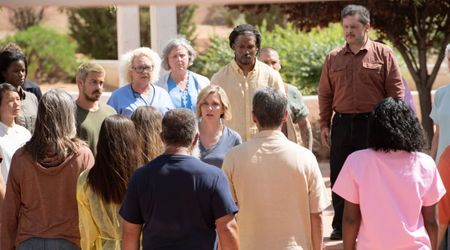'Vikings Valhalla' Season 3: Does Jomsborg really exist? Exploring Netflix show's iconic location

LOS ANGELES, CALIFORNIA: 'Vikings: Valhalla' Season 2 introduces Jomsborg, a new and pivotal setting poised to become as crucial to the series as Kattegat.
While the show is set over a century after the events of the original 'Vikings' series, it revisits key locations such as Kattegat and Uppsala.
Both these places faced devastation by Christian berserkers and Olaf Haraldsson’s army in Season 1. While Kattegat is being rebuilt and adapting to new leadership, Uppsala lies in ruins.
In Season 2, pagans left without a home or sanctuary were taken to Jomsborg, deemed the new Uppsala. Freydis became a beacon of hope for this community, believing she had found her rightful place in Jomsborg.
However, she uncovered dark secrets harbored by Jomsborg and its leaders, sparking essential changes within the community.
Given that Kattegat is a real historical location, viewers might wonder if Jomsborg is similarly rooted in history or if it is a fictional creation for the series.
This question adds another layer of intrigue to the show's blending of historical fact and creative storytelling, inviting audiences to explore both the real and imagined worlds of the Viking Age.
What is the historical origins and location of Jomsborg?

Jomsborg, featured in 'Vikings: Valhalla' Season 2, was a real place but is considered semi-legendary due to limited reliable sources.
Its exact location is unclear, but it's believed to have been on the southern coast of the Baltic Sea, near the eastern outlet of the Oder River. The Gesta Wulinensis ecclesiae pontificum, discovered in 2019, is the only source providing a precise location.
Some archaeologists believe it matches descriptions found in the sagas, suggesting Jomsborg could be the present-day town of Wolin in northwestern Poland.
According to the Knytlinga Saga and Fagrskinna, Danish king Harold Bluetooth built Jomsborg, while the Jomsvikinga Saga attributes its founding to Danish Viking Palnatoki.
Descriptions of Jomsborg align with its portrayal in 'Vikings: Valhalla,' depicting it as a fortress with a harbor, a stone tower with catapults, and an iron gate controlling the harbor entrance.
The Heimskringla saga recounts that Magnus the Good, son of Olaf Haraldsson and nephew of Harald Hardrada, destroyed Jomsborg as part of consolidating his control over Norway and Denmark.
What is Jomsborg's significance in Season 2 of 'Vikings: Valhalla'?

In 'Vikings: Valhalla' Season 2, Jomsborg undergoes significant transformation under Freydis's leadership following Harekr's death.
While historical records do not depict Jomsborg as a pagan temple or refuge, the series takes creative liberties to portray it in that light.
Freydis takes charge, opening the temple to all residents and ending the exploitation endured under Harekr's rule.
With ambitions to establish Jomsborg as the new Uppsala, Freydis aims to train residents as warriors and shieldmaidens, potentially making Jomsborg a formidable community.
However, looming threats remain. Olaf's son, Magnus, could seek vengeance for his father's death, posing a new danger to Jomsborg's newfound stability.
As tensions escalate, Jomsborg faces uncertainty about its future security and status in the tumultuous world of 'Vikings: Valhalla.'
'Vikings: Valhalla' Trailer
'Vikings: Valhalla' season 1 and 2 is available for streaming on Netflix.










